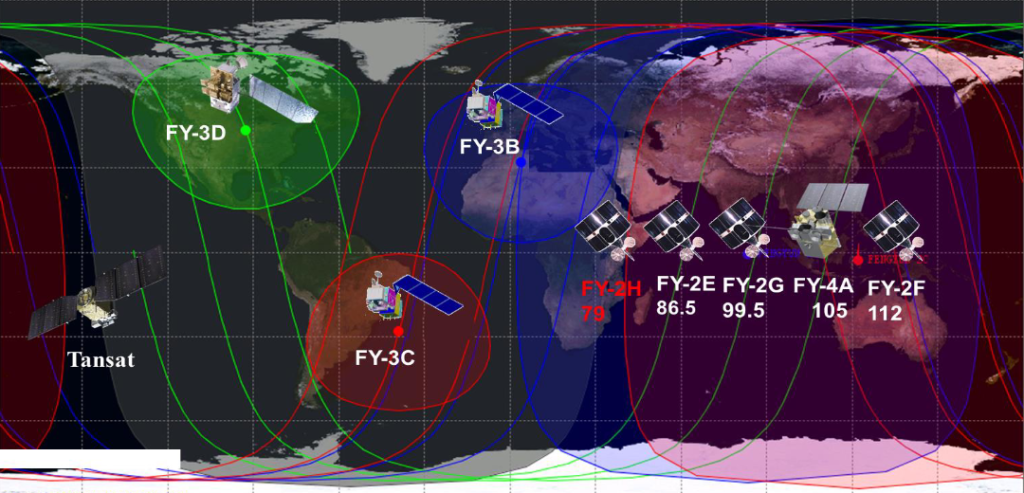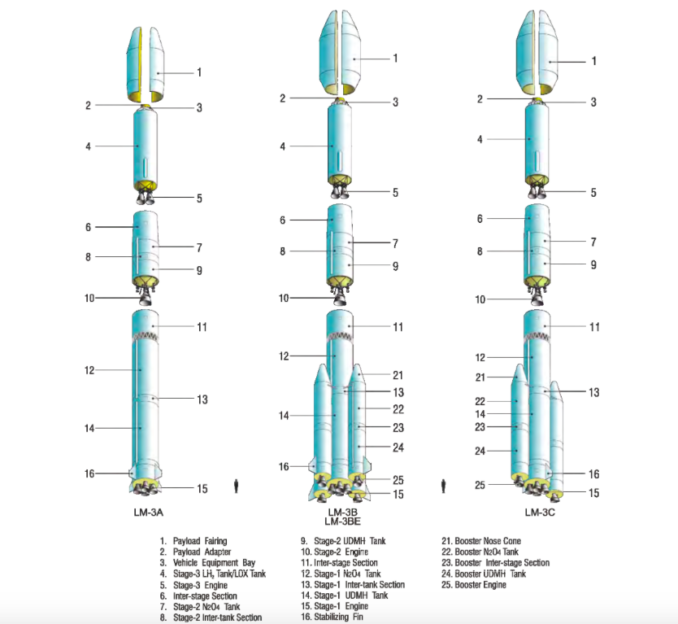Featured image credit: Xinhua
Lift Off Time/Launch Window | June 02, 2021 – 16:25 UTC June 03, 2021 – 00:25 BJT |
|---|---|
Mission Name | Fengyun 4B, a geostationary meteorology satellite |
Launch Provider | China Aerospace Science and Technology Corporation (CASC) |
Customer | China Meteorological Administration (CMA) |
Rocket | Long March 3B/E |
Launch Location | LC-2/3, Xichang Satellite Launch Center, China |
Payload mass | 5,380 kg (~ 11,800 lb) |
Where is the satellite going? | Geostationary Transfer Orbit (GTO) |
Will they be attempting to recover the first stage? | No, this is not a capability of the Long March 3B/E rocket |
Where will the first stage land? | It will crash over north east China |
Will they be attempting to recover the fairings? | No, this is not a capability of the Long March 3B/E rocket |
Are these fairings new? | Yes |
How’s the weather looking? | N/A |
This will be the: | – 15th Chinese launch of 2021 – 3rd launch of a Long March 3B/E in 2021 – 74th launch of any Long March 3B variant – 49th orbital launch attempt of 2021 |
Where to watch | If available, an official livestream will be listed here |
What does all this mean?
Fengyun-4B is China’s next generation weather satellite. It will be launched on top of a Long March 3B/E rocket from Xichang Satellite Launch Center, China and deployed into a geostationary transfer orbit (GTO). Over the following months it will gradually raise its orbit until it is located in a geostationary orbit (GEO) at 86.5° east keeping its position over China.
Fengyun-4B
The Fengyun-4B geostationary meteorology satellite is China’s 2nd generation of GEO weather satellites with a planned lifespan of 7 to 8 years. Fengyun-4A, its predecessor, was a tech demonstration satellite that was launched in 2016 and entered service in 2018 after post-launch tests concluded on December 31, 2017. This time, Fengyun-4B has overall improved systems that will further improve weather monitoring and forecasting for the China Meteorological Administration (CMA).

Based on the SAST5000 satellite bus, Fengyun-4B will have a mass of around 5,380 kg (~11,800 lb). It measures around 3.4 x 2.2 m and utilizes monomethylhydrazine (MMH) and mixed oxides of nitrogen (MON-1) as on board propellants that Fengyun-4B can use to get into its destined orbit. Equipped with a single three-panel solar array and lithium ion (Li-Ion) batteries, it can continuously provide 3,200 W of power to the satellites systems and instruments.

Instruments featured on the Fengyun-4B satellite are:
- GIIRS (Geostationary Interferometric Infrared Sounder)
- LMI (Lightning Mapping Imager)
- AGRI (Advanced Geostationary Radiation Imager)
- SEMIP (Space Environment Monitoring Instrument Package)
- SXEUV (Solar X-EUV Imaging Telescope)
- DCS (Data Collection Service)

Geostationary Interferometric Infrared Sounder
The Geostationary Interferometric Infrared Sounder, or GIIRS, is a new instrument for the Fengyun-4 satellites that enables them to gain insight into the internal constitution of the atmosphere. It can measure and monitor important parameters like:
- atmospheric temperature
- cloud top height and temperature
- sea surface temperature
- humidity levels
- integrated water vapor measurements
- cloud cover
- land surface temperature
- horizontal winds
- total column ozone
- cloud type discrimination
The GIIRS achieves this through infrared channels at 4.44 to 6.06 µm and 8.85 to 14.3 µm, and 550 to 750 nm in the supporting visible channel. These detectors have a resolution of 8 km in the infrared bands and 1 km in the visible band.
Lightning Mapping Imager
As the name already suggests, Fengyun-4B will feature the Lightning Mapping Imager, whose goal is it to measure lightning activity in real time that will help with storm tracking. Furthermore, the LMI will gather lightning data for scientific research and studies on Earth’s electric field. The imager is able to capture 500 frames per second, but instead of transmitting the raw data, it processes the images in real time, allowing meteorologists to use lightning data in nearly real time.

Advanced Geostationary Radiation Imager
The Advanced Geostationary Radiation Imager, or AGRI, is Fengyun-4B’s primary optical instrument. It is a 14 channel multi spectral imager covering 450 to 900 nm in the visible and near infrared channels, as well as infrared channels ranging from 1.36 to 13.8 µm. AGRI uses an off-axis telescope allowing it to do either regional or full disk imagery every 1 or 15 minutes respectively.
| Channels | Band (µm) | Resolution (km) | Application |
|---|---|---|---|
| VNIR (Visible and Near Infrared) | 0.45 – 0.90 | 0.5 – 1 | Aerosols, Clouds, Fog, Vegetation |
| SWIR (Shortwave Infrared) | 1.36 – 2.35 | 2 – 4 | Cirrus Clouds, Snow, Aerosols |
| MWIR (Midwave Infrared) | 3.5 – 4.0 | 2 – 4 | Fire, Land Surface |
| Water Vapor | 5.8 – 7.3 | 4 | Water Vapor |
| LWIR (Longwave Infrared) | 8.0 – 13.8 | 4 | Water Vapor, Clouds, Sea Surface Temperature |
Space Environment Monitoring Instrument Package
Fengyun-4B also monitors space weather to a certain extent. The Space Environment Monitoring Instrument Package (SEMIP) consists of two instruments. The Space Environment Monitor measures energetic and charged particles that are either trapped in Earth’s magnetosphere or coming from cosmic sources like the Sun. The Field Package on the other hand is equipped with a magnetometer, a dosimeter, and surface charging sensors that monitor the environment around the spacecraft itself to better understand potentially hazardous conditions the satellite encounters in its space environment.
Solar X-EUV Imaging Telescope
The Solar X-EUV Imaging Telescope (SXEUV) is another space weather instrument on Fengyun-4B. SXEUV is designed to capture X-rays, as well as extreme ultraviolet radiation from 10 to 130 nm, which can be used to monitor solar activity and forecast solar phenomena capable of impacting space weather.
Data Collection Service (DCS)
The Data Collection Service system, or DCS system, is designed to receive in-situ measurements of meteorological data from DCS platforms that can be located anywhere in the reach of the Fengyun-4B satellite. That date gets uplinked to the satellite and forwarded to ground stations for processing, allowing near real-time measurements from remote locations.
Fengyun Satellite Family
Fengyun is Chinese for “Winds and Clouds” and is the name of China’s weather forecasting satellite family. The constellation comprises Fengyun-1, Fengyun-2, Fengyun-3, and Fengyun-4 satellites. While Fengyun-1 and -2 have been the first generation of LEO and GEO weather satellites respectively, Fengyun-3 and -4 are China’s second generation weather satellites in the same orbits.
| Name | Orbit | Stabilization Method | Status | First Launched |
|---|---|---|---|---|
| Fengyun-1A/D | SSO | Three-Axis Stabilized | Not Operational | September 06, 1988 |
| Fengyun-2A/C | GEO | Spin-Stabilized | Not Operational | June 10, 1997 |
| Fengyun-2D/G | GEO | Spin-Stabilized | Operational | December 08, 2006 |
| Fengyun-3A | SSO | Three-Axis Stabilized | Not Operational | May 27, 2008 |
| Fengyun-3B/D | SSO | Three-Axis Stabilized | Operational | November 04, 2010 |
| Fengyun-4A | GEO | Three-Axis Stabilized | Operational | December 10, 2016 |
| Fengyun-4B/G | GEO | Three-Axis Stabilized | Planned | Expected NET May 29, 2021 |
The China Meteorological Administration plans to launch Fengyun-4B to Fengyun-4G in the upcoming years and decades, covering their need for meteorology satellites until 2040, with the last satellite planned to launch in 2033.

Long March 3B/E
The Long March 3B/E is an expandable three stage medium-lift rocket, with an optional fourth stage. The rocket has four liquid-fueled side boosters, and is an improved version over the original Long March 3B. It first launched in 2007 and has, due to its upgrades, better payload capabilities to GTO. Specifically, it was increased from 5,100 kg to 5,500 kg compared to the original Long March 3B.
The Long March 3B series features the following sections or stages from ground to nose:
- Side boosters
- First (center) stage
- Second stage
- Third stage
- Optional fourth stage

Side Boosters
The Long March 3B/E utilizes four side boosters that each use one YF-25 engine, which is powered by Unsymmetrical Di-Methyl Hydrazine (UDMH) and Nitrogen Tetroxide (N2O4). Measuring 16.1 m in length, the side boosters produce 740 kN of thrust at lift off, with the engines burning for 140 s and an ISP of 260 s.
First (center) Stage
The first stage has four YF-21C engines, which again uses UDMH and N2O4 as propellants. The first stage has an ISP of 260 seconds and produces 2,960 kN of thrust at sea level. The Long March 3B/E’s first stage measures 3.35 m in diamter and 24.76 m in hight.
Second Stage
The second stage is powered by a single YF-22E engine. However, attitude control is provided by a single YF-23 Vernier engine, and combined, these engines are known as a YF-24 module. Just like the side boosters and the first stage, the engine runs on UDMH and N2O4 and produces 742 kN of thrust. The second stage is again 3.35m in diameter and 12.9 m tall, while burning for apporximately 185 seconds during flight.

Third Stage
The Long March 3B/E third stage is 12.4 m (40.7 ft) long and is powered by two YF-75 engines. Unlike the other stages, this stage is high energy/efficiency stage powered by liquid hydrogen (LH2) and liquid oxygen (LOx). Since this engine only performs in the vacuum of space, efficiency is more important than thrust, it only produces 157 kN, while having a specific impulse of around 440 s.
Optional Fourth Stage
The optional fourth stage again runs on UDMH and N2O4, and has a singular YF-50D engine producing 6.5 kN at an ISP of 315 s. It is unclear if this stage will be used for this launch.



